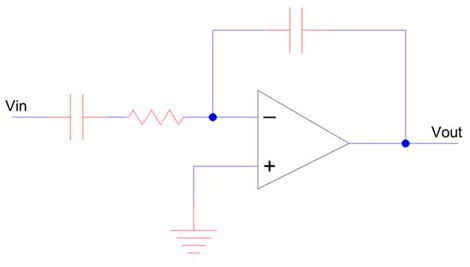Bad Circuit
Design 5 - Not Providing a DC Path
Perhaps
one of the more common bad designs is not providing a DC path to the input of a
circuit.
Consider
the op-amp circuit seen below. This looks like a classic linear circuits op-amp
problem.
In
a real implementation of this circuit the DC voltage on the inverting op-amp
input is unknown
and
so the circuit will not function properly. A very large resistor can be placed
across the feedback
capacitor
to provide a DC path to the input (large so that it only affects the DC
performance of the
circuit).
Why canít we put a large resistor across the capacitor connected to the input
to provide the
DC
path needed to get the circuit to work? Answer, the op-ampís offset voltage
will cause the op-amp
output
to rail (go to the power supply rails). We need the negative feedback from the
output back
to
the input to ensure the op-amp biases up to the correct DC operating point.
Note
that with the large resistor across the feedback capacitor the DC gain of the
circuit is 0 while
without
the feedback resistor the DC gain is unknown.
So
does the circuit work if we remove the capacitor connected to the input (the
resulting circuit is
an
integrator)? Answer, no. There still needs to be feedback from the output back
to the input to
set
a DC operating point that compensates for the op-ampís offset. Practically,
this feedback can
be
implemented with (again) a large resistor across the feedback capacitor, a
reset switch across the
feedback
capacitor (see Figs. 25.25b or 31.50), or if the integrator is part of a
feedback loop (see
Fig.
29.47 assuming the capacitor connected below to Vin isnít present).

This
problem can also be a major concern when using floating gate devices in analog
design, see
Sec.
16.3.3. Generally, the devices are erased and then slowly programmed with a
program-verify
to
ensure that they have the desired electrical characteristics. Practically this
is a challenge for a
manufacturable
analog integrated circuit because the programming has to be precise (< mVs).
Below
is one final example of not providing a DC pathÖthis circuit wonít work!
